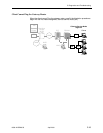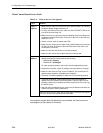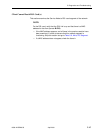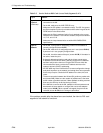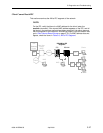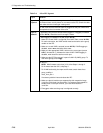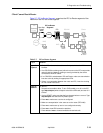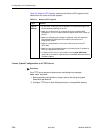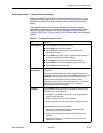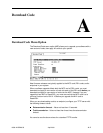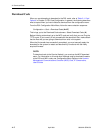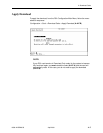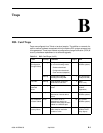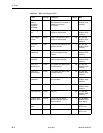
5. Diagnostics and Troubleshooting
8000-A2-GB26-50 April 2001
5-21
Performance Issues – Viewing Network Statistics
The previous sections of this document examined connectivity issues, i.e., the
inability to Ping the router. Table 5-9, Examining Performance Issues, presents
information on viewing DSL card statistics screens to examine performance
issues.
These statistic screens give information related to the number of packets
transmitted and received on an interface as well as any packet failures. Refer to
Physical Layer Menu Options
in the
Hotwire Management Communications
Controller (MCC) Card, IP Conservative, User’s Guide
for details on the Statistics
screens.
Table 5-9. Examining Performance Issues
To . . . Go To . . .
View Statistics
Screen
B-B-B
to view Ethernet statistics.
Screen
B-B-C
to view HDLC statistics.
Screen
B-B-D
and choose a port to view the DSL Link
performance summary.
Screen
B-B-E
and choose a port to view how many packets are
on the link, view DSL performance statistics.
Screen
B-B-F
to view Error statistics and choose a port.
Screen
B-B-G
to view Transmit statistics and choose a port.
Screen
B-A-C
to view System Log.
Examine Slow
Performance
Screen
B-B-B
. Slow performance could result from errors seen on
this screen.
Make sure the DSLAM and IPC are both operating at either full- or
half-duplex mode. On the AN, go to screen
A-B-A
. On the IPC, enter
10/100cfg
. If operating at full-duplex, a hub should not be used.
Check the Ethernet Statistics screen for excessive Cycle
Redundancy Check (CRC) errors, a bad connection, or a bad cable
(see
DSL Monitoring Physical Layer Screens
in Chapter 4,
Monitoring the Hotwire DSL System).
Examine
Collisions
Screen
B-B-B
. Minimal collisions are acceptable if packets are not
being discarded. Excessive collisions could result from forcing too
much data over a single Ethernet.
1. Determine if your network is too large or long (single Ethernet
cable or end-to-end cable).
2. Check to see if there are too many repeaters.
3. Check to see if there are too many users on a single Ethernet.
Intranetworking communication problems:
1. Verify that the internetworking network cables meet IEEE
standards for local Ethernet networks.
2. Check cable connections to chassis and other devices in the
network.
3. Determine whether or not your system is the only one in the
network with a problem.



